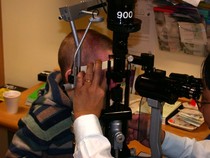
Why children can get glaucoma?
Very rarely children can get glaucoma. There are about 100 new cases in UK per year. Glaucoma in children can happen on its own, called congenital glaucoma or secondary to other eye problem e.g. congenital cataract. There may be family history of similar conditions. Childhood glaucoma can present at any age from birth to teenager.
How many types of childhood glaucomas are there?
There are many types of childhood glaucoma.
Primary Congenital Glaucoma
This is the commonest type of childhood glaucoma. They usually present in the first year of live. Children may present cloudy cornea, watery eyes and sensitive to light. The children may have characteristically 'big eyes' called buphthalmos.
Childhood Glaucoma after congenital cataract
This is the second commonest type of glaucoma. This is usually form after congenital cataract surgery. Therefore, it is important to monitor the children eye pressures after congenital cataract surgery as the eye pressure may become elevated at any time of the child's live.
Other secondary glaucoma
Other rarer condition like Anterior Segment Dysgenesis, aniridia, Sturge-Weber syndrome can cause secondary childhood glaucoma.
What are treatments for childhood glaucomas?
Childhood glaucoma commonly do not respond to medical treatments well although medical treatments are commonly tried first. The treatment is mainly surgery. There are many different types of surgery. The following are some common surgeries for childhood glaucoma.
Goniotomy
This is usually the first line surgery in Primary Congenital Glaucoma. The drainage angle is normally immaturely formed in congenital glaucoma, the procedure involves using a goniotomy knife making a gentle cut on the drainage angle to allow water draining through again.
Trabeculotomy
This is similar to goniotomy but a knife is passed into the drainage canal and cut inward into the eyes.
Trabeculectomy
This is a procedure making an alternative drainage channels by creating a valve like structure on top of the eye under the eye lid. The water will drain into a space called the 'Bleb' under the superficial layer of tissue 'conjunctiva'. Anti-scarring agents commonly used with this operation to prevent over-scarring after surgery and sealing off these artificial channels.
Glaucoam Drainge Device (tube-shunt)
The tube-shunt device is a tiny silicone tube about 0.5mm passing into the eye and connecting to a silicone plate working like a reservoir. This device can maintain long-term drainage as scarring tissues are unlikely going to seal off the drainage in time. This is a more complex operation therefore normally reserved for children with more complex glaucoma or the previous glaucoma surgeries have failed.




